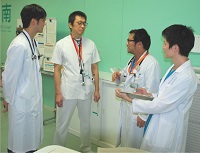Notes from the field: Hospital medicine in Japan
In Japan, hospital medicine may help to resolve several pressing issues, the biggest being the aging population.
Hospital medicine has taken root in many types of soil. The American model of diffusion and rapid expansion was unusual, but the premise of hospital medicine—patient-centered, high-quality, safe, and efficient care, provided by clinicians dedicated to the improvement of their hospitals—is not unique to the United States.
We have seen the growth of hospital medicine in Chile and Brazil, as well as Mexico and Canada. In Asia, hospital medicine has moved more slowly. However, it has grown in Taiwan and China, and last year, this column described its beginnings in India.
Each country faces different gaps that hospital medicine has attempted to fill. Whether the problem is an unfunded mandate of care, under-resourced hospitals, inadequate numbers of trained clinicians, or intense competition, we have seen a variety of ways that the basic premise of inpatient care has evolved to try to solve it.

Japan is no exception. There are deficits that need to be addressed and barriers to adoption of a hospitalist model, but a small group of hospitalists has risen to the challenge. In September 2016, a group of hospitalists from Mayo Clinic and The Queen's Medical Center in Hawaii had the pleasure of participating in the first joint Japanese-American hospitalist conference, held at the Tokyo Bay Urayasu Ichikawa Medical Center.
In Japan, hospital medicine may help to resolve several pressing issues, the biggest being the aging population. Japan is the most rapidly aging country in the world. As the total population falls, the percentage of people over 65 years old is climbing. The cost of care for the most elderly patients in Japan continues to rise, especially with end-of-life care. An increasing incidence of dementia adds another burden. Nursing homes are in short supply as cultural changes such as movement to cities and more women in the workforce create a shift away from the traditional three-generation household. The payment system is very fragmented, and health care reform is difficult but essential with increasing national debt.
There are over 8,500 hospitals in Japan, and care is not well-coordinated among competitive facilities and clinics. There are duplication and overlap of investment in technology, which lead to inefficiency. At the same time, there is fragmentation of care within facilities. The training system in Japan favors subspecialization, and there are few venues for extended general internal medicine training. A reform of the postgraduate education system in 2004 led to a match and a two-year postgraduate mandatory training period, including the possibility of six months of general medicine. However, that time can also be spent in outpatient medicine, and up to three months of it can be spent in the emergency department. This leaves trainees with little acute care experience. Subspecialty-trained doctors, of which there are an abundance, may not be suited to caring for patients with a wide variety of complex medical issues, especially in the postacute care setting.
This is where hospitalists can help. With a focus on quality and efficiency, communication and end-of-life care, they can potentially decrease this fragmentation. Hospitalists in Japan are slowly coming into the workforce. Several have had experience working in U.S. hospitals and have translated this to the Japanese medical environment. The JHospitalist network is a group of Japanese physicians who are working together to promote hospital medicine. There have been several meetings (the first was held in 2015), and since September 2013, there is a publication as well, The Hospitalist (not to be confused with several other publications with similar names, including this one).
During the Japanese-American hospitalist conference at the Tokyo Bay Urayasu Ichikawa Medical Center, physicians from several cities in Japan shared their experiences. American speakers discussed topics such as quality innovation and patient flow. There was a significant amount of debate about the need for increased general internal medicine training and the role of subspecialists in acute and postacute care. Based on the discussions at the meeting, hospital medicine appears to be spreading slowly but inexorably across the Japanese medical landscape.
Fragmented care and payments, insufficient trained staff, debt, an aging population, competition, and payment reform may sound like familiar issues to U.S. hospitalists. Similar forces, a variation on a theme—either way, we believe hospital medicine is part of the solution.



